Related Research Articles
The General Assembly of Unitarian and Free Christian Churches is the umbrella organisation for Unitarian, Free Christians, and other liberal religious congregations in the United Kingdom and Ireland. It was formed in 1928, with denominational roots going back to the Great Ejection of 1662. Its headquarters is Essex Hall in central London, on the site of the first avowedly Unitarian chapel in England, set up in 1774.

Bolton is a town in Greater Manchester in England. In the foothills of the West Pennine Moors, Bolton is between Manchester, Blackburn, Wigan, Bury and Salford. It is surrounded by several towns and villages that form the wider borough, of which Bolton is the administrative centre. The town is also within the historic county boundaries of Lancashire.

Horwich is a town and civil parish in the Metropolitan Borough of Bolton, Greater Manchester, England, within the Historic County Boundaries of Lancashire. It is 5.3 miles (8.5 km) southeast of Chorley, 5.8 miles (9.3 km) northwest of Bolton and 15 miles (24 km) northwest of Manchester. It lies at the southern edge of the West Pennine Moors with the M61 motorway passing close to the south and west. At the 2011 Census, Horwich had a population of 20,067.
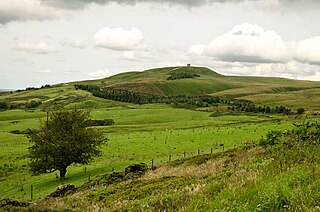
Rivington is a village and civil parish of the Borough of Chorley, Lancashire, England, occupying 2,538 acres. It is about 6 miles (9.7 km) southeast of Chorley and about 8+1⁄2 miles (13.7 km) northwest of Bolton. Rivington is a rural area consisting primarily of agricultural grazing land, moorland, with hill summits including Rivington Pike and Winter Hill within the West Pennine Moors. The area has a thriving tourist industry centred around reservoirs created to serve Liverpool in the Victorian era and Lever Park created as a public park by William Lever at the turn of the 20th century, with two converted barns, a replica of Liverpool Castle and open countryside. Rivington and Blackrod High School is located here. Rivington and its village had a population of 109 at the 2011 Census.
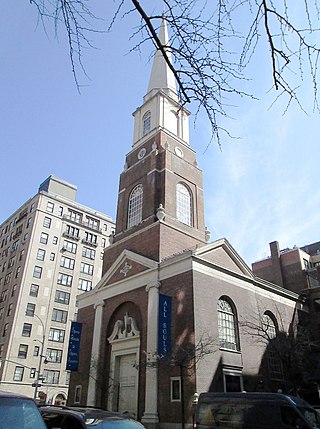
The Unitarian Church of All Souls at 1157 Lexington Avenue at East 80th Street in the Upper East Side of Manhattan, New York City was built in 1932 and was designed by Hobart Upjohn – Richard Upjohn's grandson – in the Neo-colonial style with a Regency-influenced brick base. It is the congregation's fourth sanctuary. The congregation, dating back to 1819, was the first Unitarian Universalist congregation in the city. It has provided a pulpit for some of the movement's leading theologians and has also recorded many eminent persons in its membership.
William Bolling was an English Tory and later Conservative politician who sat in the House of Commons in two periods between 1832 and 1848.

Upper Chapel is a Unitarian chapel on Norfolk Street in Sheffield City Centre. It is a member of the General Assembly of Unitarian and Free Christian Churches, the umbrella organisation for British Unitarians. The Chapel is Grade II listed.
Greenacres, archaically Greenacres Moor, is an area of Oldham, in Greater Manchester, England. It lies on the west side of the River Medlock opposite the village of Lees.
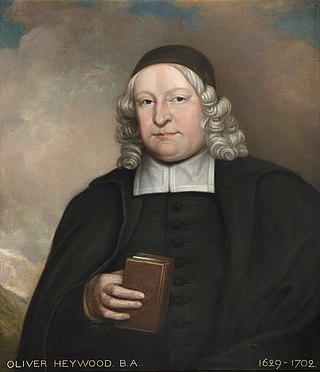
Oliver Heywood (1630–1702) was a British nonconformist minister, ejected for his beliefs.
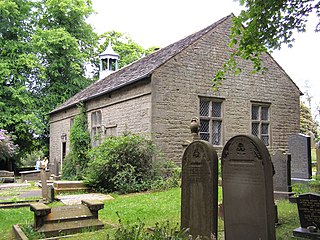
Rivington Unitarian Chapel is an active place of Unitarian worship in Rivington, Lancashire, England. It was founded in 1703, although its congregation dates to 1667. It is designated as a Grade II* listed building with some restoration in 1990, and hs ongoing preservation.
George Harris was a British Unitarian minister, polemicist and editor.
Samuel Bourn the Elder (1648–1719) was an English dissenting minister. His maternal uncle was Robert Seddon, who became minister at Gorton, Lancashire and Langley, Derbyshire, where he was silenced in 1662. Seddon sent Bourn to Emmanuel College, Cambridge, which he left in 1672. His tutor was Samuel Richardson, who taught that there is no distinction between grace and moral righteousness and salvation is dependent upon the moral state. It does not appear that Bourn accepted this view; his theology was always Calvinistic and, although he regretted deflectors from that system, he was no hunter of heretics.
James Bradshaw, was an English clergyman and ejected minister.
Thomas Dixon was an English nonconformist minister and tutor.
John Seddon (1719–1769) was an English Unitarian minister.

The Octagon Chapel, Liverpool, was a nonconformist church in Liverpool, England, opened in 1763. It was founded by local congregations, those of Benn's Garden and Kaye Street chapels. The aim was to use a non-sectarian liturgy; Thomas Bentley was a major figure in founding the chapel, and had a hand in the liturgy.
The Old Jewry Meeting-house was a meeting-house for an English Presbyterian congregation, built around 1701, in the Old Jewry, a small street in the centre of the City of London. Its first minister was John Shower. In 1808 new premises were built in Jewin Street.

Joshua Routledge was an engineer and inventor of the early 19th century during the Industrial Revolution.
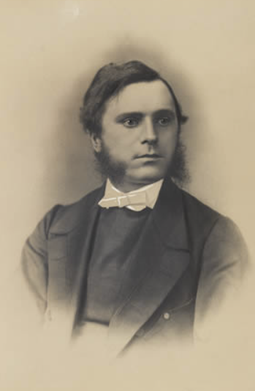
Charles Clement Coe was an English Unitarian minister and writer who advocated non-Darwinian evolution.
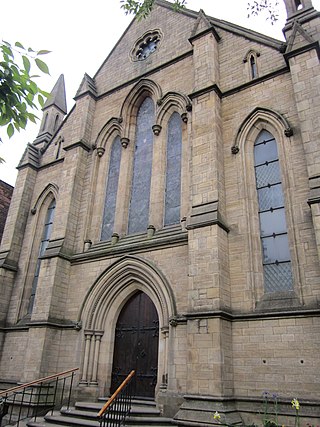
Bank Street Unitarian Chapel is a Unitarian place of worship in Bolton, Greater Manchester, England.
References
- ↑ Bank Street Chapel (1896). Bank Street Chapel, Bolton, Bi-centenary Commemoration 1696-1896 (PDF). Philip Green (London); H. Rawson & Co. (Manchester). p. 141.
- ↑ Farrer, William; Brownbill, J, eds. (1911). "The parish of Bolton-le-Moors". A History of the County of Lancaster: Volume 5. British History Online. pp. 235–243.
- ↑ Hardman, Malcolm (2003). Classic Soil: Community, Aspiration, and Debate in the Bolton Region of Lancashire, 1819-1845. Fairleigh Dickinson University Press. p. 166. ISBN 978-0-83863-966-5.
- 1 2 "Mr Baker's Lectures on Nonconformity in Bolton". The Christian Reformer, or, Unitarian Magazine and Review. X (CXVI): 480–490. August 1854.
- ↑ Hardman, Malcolm (2003). Classic Soil: Community, Aspiration, and Debate in the Bolton Region of Lancashire, 1819-1845. Fairleigh Dickinson University Press. p. 31. ISBN 978-0-83863-966-5.